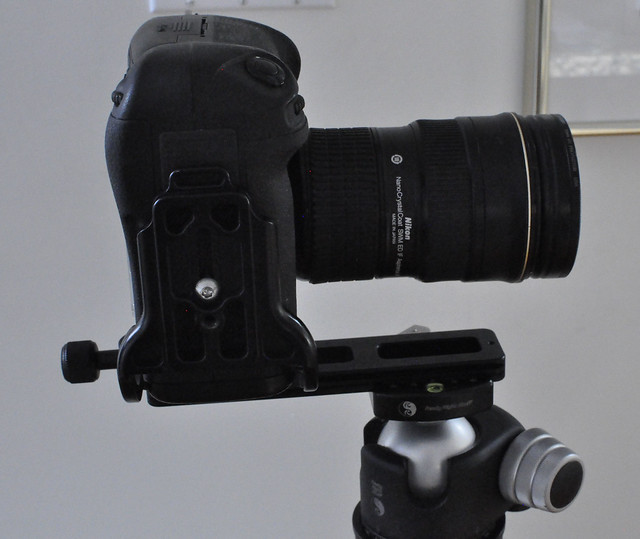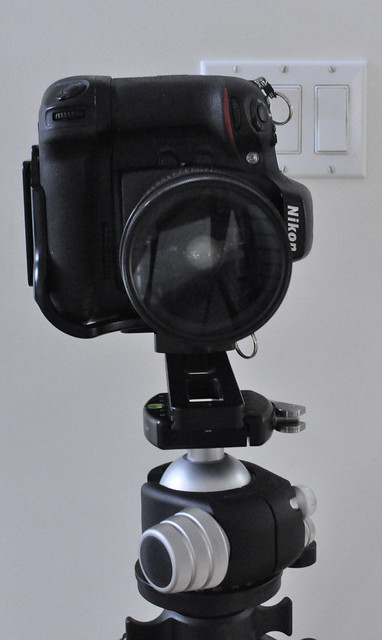Tomorrow I'm going to attempt my first panoramic shot, it will be of a river/waterfall (the second one in this thread : Couple of shots from a wet morning...)
I'm going to do a bit of reading up on it later, but does anyone have any tips or do's and don'ts etc?
Many thanks
Results 1 to 11 of 11
Thread: Panoramic Shots
-
25th April 2015, 03:52 PM #1
Panoramic Shots
-
25th April 2015, 03:56 PM #2
Re: Panoramic Shots
Never tried it Matt, but good luck, looking forward to seeing your images!

-
25th April 2015, 04:28 PM #3
Re: Panoramic Shots
Matt,
I have done very little of this, but I do have one suggestion: leave room at the top and bottom of the images. Depending on the projection you use, you will have various kinds of curved edges top and bottom, and you will lose some area when you crop down to a rectangle.
I did mine in Photoshop, but I just watched a Julieanne Kost video of the panorama stitching on the new Lightroom Creative Cloud, and it looks great. That's what I will be using next time I do this.
Good luck, and I look forward to seeing the results.
Dan
-
25th April 2015, 04:32 PM #4
Re: Panoramic Shots
Cheers both, I've just had a quick read online and it says to avoid any movement including water... which blows my plans out of the water (excuse the pun) a bit.
-
25th April 2015, 04:40 PM #5
Re: Panoramic Shots
It depends on how far you are from the foreground elements in the image. I do a fair bit of pano work and try to use a tripod whenever possible.
Camera should be in the vertical (portrait) orientation and you should allow a minimum of 10% overlap on each side of each frame that the stitching software can use to align each of the shots. The camera should be as level as possible and ideally you will rotate it around the no-parallax point for the specific lens and focal length. I find the use of an L-bracket and an extension bar quite useful. If your camera does not have a built in level, a bubble level on the hot shoe is useful too.
When shooting, take a light reading across the scene and shoot at a shutter speed and aperture that ensures that you do not blow out the highlights. I meter the entire scene and then pick an ISO / shutter speed / aperture combination that will work all the way across the scene from end to end; I shoot 100% manual as you don't want the camera to change exposure between the shots. Focus the camera and then turn off autofocus (you don't want the focus point to change between shots).
I will take a picture of one finger in the sequence; to me this indicated that the next shot is the beginning of the sequence and then I put 2 fingers right after the last shot. This indicates the end of the sequence to me. I will take two or three sequences of every pano. One bad shot can ruin and entire pano, so I want some insurance that I got it.
If you are shooting hand-held; try to make sure that there is nothing in the foreground that is fairly close to the camera, otherwise you will get some serious distorion / curvature issues in your pano. If there is, you need the tripod / L-bracket / extension bar (or pano tool) to get this looking right.
In post (if you are shooting RAW), process one of the key images properly and then use whatever tools you have to process the rest of the sequence identically (I do my work in ACR). Make sure you use the distortion correction functionality of the post processing software to get rid of any lens related distortion in the image you plan to stitch together.
If you have the L-bracket and and extension bar, work out and record where the no parallax point is for each lens (and this can change for different focal lengths on the same lens). There are a number of YouTube videos and websites that show you how to do this (it is a bit time consuming, but definitely worth it.).
The rig I shoot panos with looks like this and is not one of the higher end setups from a company like Nodal Ninja:


-
25th April 2015, 04:44 PM #6
-
25th April 2015, 06:02 PM #7

- Join Date
- Dec 2011
- Location
- Cobourg, Ontario, Canada
- Posts
- 2,509
- Real Name
- Allan Short
Re: Panoramic Shots
Manfred has some very good info, I also shot a lot of pano's, the difference is I do not use a nodal bar as I find unless I have something very close in the foreground the stitching programs now a days does and excellent job. As for the finger (just wanted to say that), as I usually pan left to right I stick my left hand in front of the lens and take a shot before taking the rest of the shots, and then my right hand to let me know that the pan is finished. As for flowing water I do that all the time when I can, however as I am a ND junkie I am usually want to milk the water, if fast flowing than 1/2 sec to an 1/8th sec maybe enough, if slow flowing than 1 sec to 5 sec maybe needed it depends on what you like.
Matt if you get into pans' than a L-bracket is the way to go, now Manfred's like mine is from Really Right Stuff, and that quick release clamp you see if also from the same maker. If you were to use that exact clamp then you must use bars, rails, and brackets from RRS as only they will work with that exact clamp. If it is a screw tighten clamp then it does not matter.
Once you use the rig that myself and Manfred use, the L-bracket, that quick release clamp on top of a good ball head you will wonder how you every worked without it. Yes RRS goes cost more than some others, however you get want you pay for and as the name implies they make Really Right Stuff of the photographer.
Cheers: Allan
-
25th April 2015, 07:45 PM #8
Re: Panoramic Shots
Actually both my L-bracket and bar are from Kirk, not RRS. Both make Arca-Swiss compatible mounts and these are interchangeable. My ballhead is RRS, although I would not hesitate to recommend Kirk or Markins heads either. All three companies make excellent ball heads. For the Europeans, I would also not hesitate to look at either Arca-Swiss or Novoflex products. Both companies put out excellent products, but are quite pricey on this side of the Atlantic and the other three companies (RRS and Kirk are American and Markins is South Korean) are simply more competitively priced.
The L-bracket should be camera model specific. Yes, you can find cheap Chinese knockoffs on the internet, but....

Last edited by Manfred M; 25th April 2015 at 11:53 PM. Reason: Added Arca-Swiss and Novoflex
-
25th April 2015, 08:27 PM #9

- Join Date
- May 2011
- Location
- SE Michigan
- Posts
- 4,511
- Real Name
- wm c boyer
Re: Panoramic Shots
I do a fair amount of photo-merging, all using Photoshop. Unlike Manfred, I don't concern myself
with the nodal thing but, I do tend to overlap more like 20-30% and don't use a lens less than 180mm.
Otherwise, whatever he said does apply. Additionally, there are numerous merge options in PS,
try them all as one might work better for a specific image than another.
On a really difficult image, like windy water, you may need to resort to one, or more, of the many
distortion tools available to get the waves to match up...can be a real PITA.
-
25th April 2015, 10:06 PM #10

- Join Date
- Apr 2012
- Location
- Dunedin New Zealand
- Posts
- 2,697
- Real Name
- J stands for John
Re: Panoramic Shots
The advantage of organising at least 30% overlap is that if there is movement or something you do not want on one version of reality then you can pick the other frame* .... in the last Pano I did I ignored on complete frame as I was rather generous in the overlap of the two adjacent ones. I have rarely shot in the vertical format and with the narrow width of the DSLR I can see why one would be tempted to reduce overlap. I tried using a tripod and it resulted in such a mess that I have never repeated the experiment ... but of course one should work as if the camera is on a tripod. My first digital, a Canon P&S taught me how to shoot panos because it showed me what I had just taken to match up the next frame incorporating overlap.

I have three stitch programmes which came with new cameras but prefer and except for 'quick and nasty' jobs use my editor where I have control over the process ... but as with many things not all 'editors' are equal.
*In one case the subject, a fishing trawler, was too big as it passed me so I waited for it to clear and then shot the scene without it. "Fishing Fleet"

The harbour master would have had pups if this had been reality
I do not think having water in the shot should be a problem if you are careful with the editing.
Most editing is common sense and an appreciation of what is 'right' even if unreal as in my example.
Edit .. if the scene requires you to tilt the camera up or down then be very generous with overlap so that you can apply perspective correction to each frame prior to the stitch.
Edit #2 Do not use a polarising filter and more frames with a longer lens is better than the common mistake in using a WA lens ... though I am sure that will draw forth various claims of doing it with WA lens LOL
Last edited by jcuknz; 25th April 2015 at 10:24 PM.
-
25th April 2015, 11:24 PM #11
Re: Panoramic Shots
I can't recall having any issues with water, even with some of my earliest panos.

However (same shot before serious PP work), shows what happens when the straight wall with railing in front of me was captured with the camera mounted on an L-bracket, was rotated around the tripod mount, not the no-parallax point. I suspect I was not 100% spot on being level either.

This is the image that turned into the first one after more PP work.

 Helpful Posts:
Helpful Posts: 
 Reply With Quote
Reply With Quote
